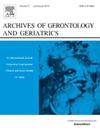Resistance training and blood pressure: Insights from a meta-analysis of the aging population
IF 3.5
3区 医学
Q2 GERIATRICS & GERONTOLOGY
引用次数: 0
Abstract
Background
Hypertension is a prevalent cardiovascular risk factor in older adults, contributing to morbidity and mortality worldwide. While aerobic exercise is well-established for blood pressure (BP) management, the role of resistance training (RT) in aging populations remains less clear, with inconsistent findings across studies.
Objective
To evaluate the effect of RT on BP in adults aged 60 and older and explore moderators such as intervention duration, gender, and session frequency.
Method
Following PRISMA guidelines, we searched PubMed, Web of Science, Scopus, Cochrane Library, and Google Scholar for randomized controlled trials (RCTs) of RT (≥4 weeks) in older adults (mean age ≥60 years), published until February 2025. Data on systolic, diastolic, and mean BP were pooled using random-effects models, with subgroup and meta-regression analyses to assess heterogeneity sources.
Results
Fifty-one RCTs (n = 2025) demonstrated that RT significantly reduced systolic BP (MD = -6.11 mmHg), diastolic BP (MD = -2.53 mmHg), and mean BP (MD = -4.10 mmHg; all p < 0.001). Subgroup analysis revealed larger systolic (females: -7.95 mmHg; males: -6.02 mmHg, NS) and diastolic BP reductions (females: -4.24 mmHg; males: -3.39 mmHg, NS), with mean BP reduced significantly in both sexes (females: -4.02 mmHg; males: -7.08 mmHg). Short-term (≤12 weeks) and higher frequency interventions enhanced BP reductions. Heterogeneity was high but sensitivity analyses confirmed robustness.
Conclusion
RT effectively lowers BP in older adults, supporting its inclusion in hypertension management strategies. Short-term, frequent RT protocols may optimize outcomes, particularly for females. Further research is needed to explore long-term effects and underlying mechanisms.
抗阻训练和血压:来自老龄化人口荟萃分析的见解
背景:高血压是老年人普遍存在的心血管危险因素,在世界范围内造成发病率和死亡率。虽然有氧运动在血压(BP)管理方面已经得到了公认,但阻力训练(RT)在老年人中的作用仍不太清楚,研究结果不一致。目的评价RT对60岁及以上成人血压的影响,探讨干预时间、性别、疗程频率等调节因素。方法按照PRISMA指南,检索PubMed、Web of Science、Scopus、Cochrane Library和谷歌Scholar,检索截至2025年2月发表的老年人(平均年龄≥60岁)RT(≥4周)的随机对照试验(rct)。采用随机效应模型对收缩压、舒张压和平均血压数据进行汇总,并采用亚组和元回归分析来评估异质性来源。结果51项随机对照试验(n = 2025)显示,RT可显著降低收缩压(MD = -6.11 mmHg)、舒张压(MD = -2.53 mmHg)和平均血压(MD = -4.10 mmHg);所有p <;0.001)。亚组分析显示收缩压较大(女性:-7.95 mmHg;男性:-6.02 mmHg, NS)和舒张压降低(女性:-4.24 mmHg;男性:-3.39 mmHg, NS),男女平均血压均显著降低(女性:-4.02 mmHg;男性:-7.08 mmHg)。短期(≤12周)和更高频率的干预可增强血压降低。异质性高,但敏感性分析证实了稳健性。结论放疗可有效降低老年人血压,支持将其纳入高血压管理策略。短期,频繁的RT治疗方案可以优化结果,特别是对女性。需要进一步的研究来探索长期影响和潜在的机制。
本文章由计算机程序翻译,如有差异,请以英文原文为准。
求助全文
约1分钟内获得全文
求助全文
来源期刊
CiteScore
7.30
自引率
5.00%
发文量
198
审稿时长
16 days
期刊介绍:
Archives of Gerontology and Geriatrics provides a medium for the publication of papers from the fields of experimental gerontology and clinical and social geriatrics. The principal aim of the journal is to facilitate the exchange of information between specialists in these three fields of gerontological research. Experimental papers dealing with the basic mechanisms of aging at molecular, cellular, tissue or organ levels will be published.
Clinical papers will be accepted if they provide sufficiently new information or are of fundamental importance for the knowledge of human aging. Purely descriptive clinical papers will be accepted only if the results permit further interpretation. Papers dealing with anti-aging pharmacological preparations in humans are welcome. Papers on the social aspects of geriatrics will be accepted if they are of general interest regarding the epidemiology of aging and the efficiency and working methods of the social organizations for the health care of the elderly.

 求助内容:
求助内容: 应助结果提醒方式:
应助结果提醒方式:


